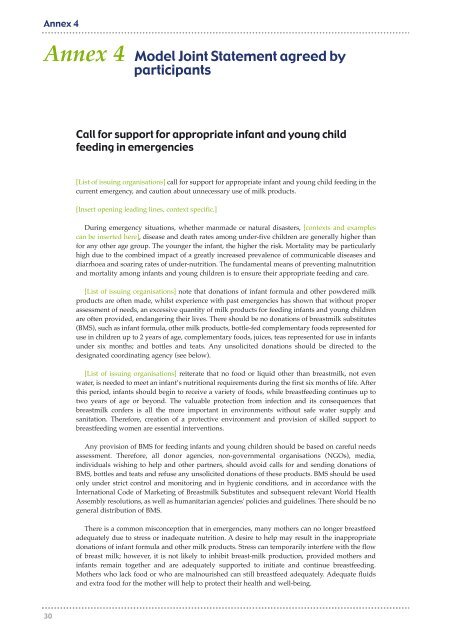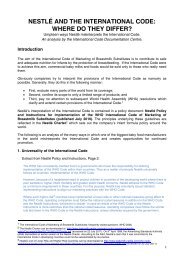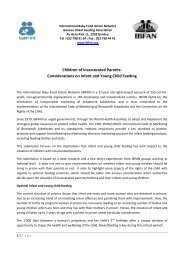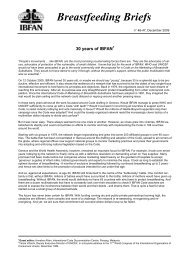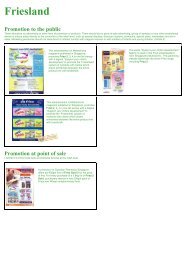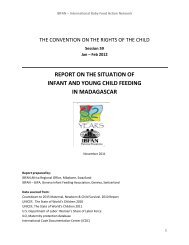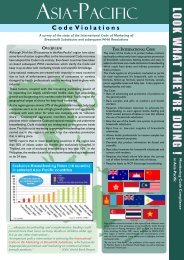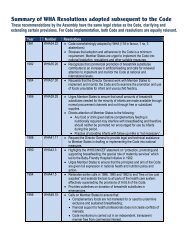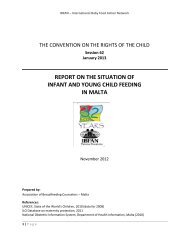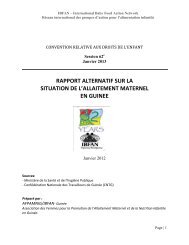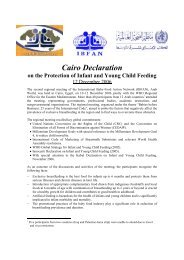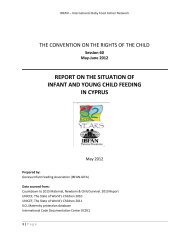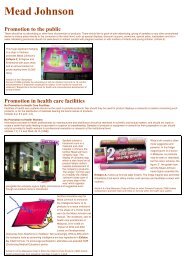Infant and young child feeding in emergencies. Making it ... - IBFAN
Infant and young child feeding in emergencies. Making it ... - IBFAN
Infant and young child feeding in emergencies. Making it ... - IBFAN
Create successful ePaper yourself
Turn your PDF publications into a flip-book with our unique Google optimized e-Paper software.
Annex 4<br />
Annex 4 Model Jo<strong>in</strong>t Statement agreed by<br />
participants<br />
Call for support for appropriate <strong>in</strong>fant <strong>and</strong> <strong>young</strong> <strong>child</strong><br />
<strong>feed<strong>in</strong>g</strong> <strong>in</strong> <strong>emergencies</strong><br />
[List of issu<strong>in</strong>g organisations] call for support for appropriate <strong>in</strong>fant <strong>and</strong> <strong>young</strong> <strong>child</strong> <strong>feed<strong>in</strong>g</strong> <strong>in</strong> the<br />
current emergency, <strong>and</strong> caution about unnecessary use of milk products.<br />
[Insert open<strong>in</strong>g lead<strong>in</strong>g l<strong>in</strong>es, context specific.]<br />
Dur<strong>in</strong>g emergency s<strong>it</strong>uations, whether manmade or natural disasters, [contexts <strong>and</strong> examples<br />
can be <strong>in</strong>serted here], disease <strong>and</strong> death rates among under-five <strong>child</strong>ren are generally higher than<br />
for any other age group. The <strong>young</strong>er the <strong>in</strong>fant, the higher the risk. Mortal<strong>it</strong>y may be particularly<br />
high due to the comb<strong>in</strong>ed impact of a greatly <strong>in</strong>creased prevalence of communicable diseases <strong>and</strong><br />
diarrhoea <strong>and</strong> soar<strong>in</strong>g rates of under-nutr<strong>it</strong>ion. The fundamental means of prevent<strong>in</strong>g malnutr<strong>it</strong>ion<br />
<strong>and</strong> mortal<strong>it</strong>y among <strong>in</strong>fants <strong>and</strong> <strong>young</strong> <strong>child</strong>ren is to ensure their appropriate <strong>feed<strong>in</strong>g</strong> <strong>and</strong> care.<br />
[List of issu<strong>in</strong>g organisations] note that donations of <strong>in</strong>fant formula <strong>and</strong> other powdered milk<br />
products are often made, whilst experience w<strong>it</strong>h past <strong>emergencies</strong> has shown that w<strong>it</strong>hout proper<br />
assessment of needs, an excessive quant<strong>it</strong>y of milk products for <strong>feed<strong>in</strong>g</strong> <strong>in</strong>fants <strong>and</strong> <strong>young</strong> <strong>child</strong>ren<br />
are often provided, endanger<strong>in</strong>g their lives. There should be no donations of breastmilk subst<strong>it</strong>utes<br />
(BMS), such as <strong>in</strong>fant formula, other milk products, bottle-fed complementary foods represented for<br />
use <strong>in</strong> <strong>child</strong>ren up to 2 years of age, complementary foods, juices, teas represented for use <strong>in</strong> <strong>in</strong>fants<br />
under six months; <strong>and</strong> bottles <strong>and</strong> teats. Any unsolic<strong>it</strong>ed donations should be directed to the<br />
designated coord<strong>in</strong>at<strong>in</strong>g agency (see below).<br />
[List of issu<strong>in</strong>g organisations] re<strong>it</strong>erate that no food or liquid other than breastmilk, not even<br />
water, is needed to meet an <strong>in</strong>fant’s nutr<strong>it</strong>ional requirements dur<strong>in</strong>g the first six months of life. After<br />
this period, <strong>in</strong>fants should beg<strong>in</strong> to receive a variety of foods, while breast<strong>feed<strong>in</strong>g</strong> cont<strong>in</strong>ues up to<br />
two years of age or beyond. The valuable protection from <strong>in</strong>fection <strong>and</strong> <strong>it</strong>s consequences that<br />
breastmilk confers is all the more important <strong>in</strong> environments w<strong>it</strong>hout safe water supply <strong>and</strong><br />
san<strong>it</strong>ation. Therefore, creation of a protective environment <strong>and</strong> provision of skilled support to<br />
breast<strong>feed<strong>in</strong>g</strong> women are essential <strong>in</strong>terventions.<br />
Any provision of BMS for <strong>feed<strong>in</strong>g</strong> <strong>in</strong>fants <strong>and</strong> <strong>young</strong> <strong>child</strong>ren should be based on careful needs<br />
assessment. Therefore, all donor agencies, non-governmental organisations (NGOs), media,<br />
<strong>in</strong>dividuals wish<strong>in</strong>g to help <strong>and</strong> other partners, should avoid calls for <strong>and</strong> send<strong>in</strong>g donations of<br />
BMS, bottles <strong>and</strong> teats <strong>and</strong> refuse any unsolic<strong>it</strong>ed donations of these products. BMS should be used<br />
only under strict control <strong>and</strong> mon<strong>it</strong>or<strong>in</strong>g <strong>and</strong> <strong>in</strong> hygienic cond<strong>it</strong>ions, <strong>and</strong> <strong>in</strong> accordance w<strong>it</strong>h the<br />
International Code of Market<strong>in</strong>g of Breastmilk Subst<strong>it</strong>utes <strong>and</strong> subsequent relevant World Health<br />
Assembly resolutions, as well as human<strong>it</strong>arian agencies' policies <strong>and</strong> guidel<strong>in</strong>es. There should be no<br />
general distribution of BMS.<br />
There is a common misconception that <strong>in</strong> <strong>emergencies</strong>, many mothers can no longer breastfeed<br />
adequately due to stress or <strong>in</strong>adequate nutr<strong>it</strong>ion. A desire to help may result <strong>in</strong> the <strong>in</strong>appropriate<br />
donations of <strong>in</strong>fant formula <strong>and</strong> other milk products. Stress can temporarily <strong>in</strong>terfere w<strong>it</strong>h the flow<br />
of breast milk; however, <strong>it</strong> is not likely to <strong>in</strong>hib<strong>it</strong> breast-milk production, provided mothers <strong>and</strong><br />
<strong>in</strong>fants rema<strong>in</strong> together <strong>and</strong> are adequately supported to <strong>in</strong><strong>it</strong>iate <strong>and</strong> cont<strong>in</strong>ue breast<strong>feed<strong>in</strong>g</strong>.<br />
Mothers who lack food or who are malnourished can still breastfeed adequately. Adequate fluids<br />
<strong>and</strong> extra food for the mother will help to protect their health <strong>and</strong> well-be<strong>in</strong>g.<br />
30


